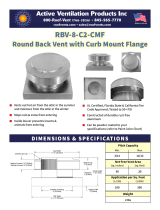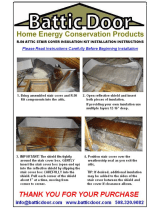
© 2014 Johns Manville Inc. All Rights Reserved | 5
Insulating Around Electrical:
Insulating Around Plumbing & Piping:
Insulating Around Windows:
Installing insulation around junction boxes that house electrical receptacles and switches,
and around wiring in walls and ceilings requires some special techniques. When
cutting insulation around wiring, be sure to keep your utility knife clear of the wires.
Junction Boxes - Hold the insulation up in the wall cavity and check where the junction box
lines up. Cut a notch in the batt for the junction box. Place that cutout of insulation behind the
junction box, and then insert the rest of the batt in the cavity.
Wiring in Walls - When electrical wiring passes through a stud cavity, split the insulation with
a utility knife and fit half in front of and half behind the wire so that the wire is nested inside
the insulation. If the wiring is located close to the inside surface, then press insulation behind
the wiring.
Wiring in Ceilings - Insulation should be placed between electrical wiring and the ceiling.
In almost any insulation project, you are bound to encounter plumbing pipes in walls and ceilings. It’s important to insulate
around these obstacles properly, especially in exterior walls where an improper installation could lead to frozen pipes.
Remember, in that particular application, the object is to block cold air from the pipes. You should have no problem tucking
JM insulation into position. Take your time to ensure that the insulation fills the width of the cavity, and do your best to eliminate
gaps wherever possible. Never stress pipes by inserting the insulation too forcefully or tightly.
In walls where plumbing fixtures are to be placed, insulation must be installed first. Where there is plumbing in exterior walls,
install the insulation BEHIND the pipes, between the pipes and the exterior. To protect pipes from freezing, insulation should
never be placed between the pipes and the warm side of the wall.
For vented crawl spaces in cold climates where water pipes run through the joists, install insulation below the pipes to protect
them from freezing.
Exterior Wall Windows - Apply sealants around all windows. Sealants can eliminate drafts, provide thermal resistance, and keep
out moisture, dust and insects. The sealants you will be using are generally of two types: caulk and urethane foam.
Caulk is a paste-like material that cures to a solid state. It is applied with a caulking gun to seal small cracks or gaps. As you
apply the caulk to these small spaces, move at a slow, steady pace, forcing caulk into the gap. Smooth excess caulk with your
fingertip or a putty knife before it dries.
Urethane foams are liquid materials that expand rapidly as they set to a semi-rigid state. They are used to fill larger gaps and
holes. The most common type is available in an aerosol can or large canister. To apply urethane foam, follow the directions on
the label. Place the nozzle over one end of the gap, and then squeeze the trigger while dragging the nozzle across the gap.
Because this material will expand, do not overfill the gap.
SPECIAL CONSIDERATIONS,
CRITICAL DETAILS & TIPS:
Keep all insulation at least 3 inches (75 mm) away from combustible sources such as chimneys, non-IC fixtures and heated
(furnace, water heater, etc.) flue pipes.















